Financial Accounting Report: Case Studies and Analysis (2017)
VerifiedAdded on 2020/10/23
|32
|3855
|370
Report
AI Summary
This report provides a comprehensive overview of financial accounting, covering key principles, rules, and regulations, with a focus on UK accounting practices. It delves into the preparation and analysis of financial statements, including income statements, balance sheets, cash flow statements, and statements of changes in equity. The report explores fundamental concepts such as the double-entry system, money measurement, going concern, and accrual concepts. It also examines the consistency and materiality conventions of accounting. Several case studies are presented, illustrating the practical application of accounting principles through journal entries, ledger accounts, trial balances, and financial statement preparation. Topics covered include bank reconciliation, control accounts, suspense accounts, and depreciation methods. The report concludes with a discussion on the significance of financial accounting in assessing a company's financial position and providing stakeholders with essential information for decision-making.

Financial Accounting
1
1
Paraphrase This Document
Need a fresh take? Get an instant paraphrase of this document with our AI Paraphraser
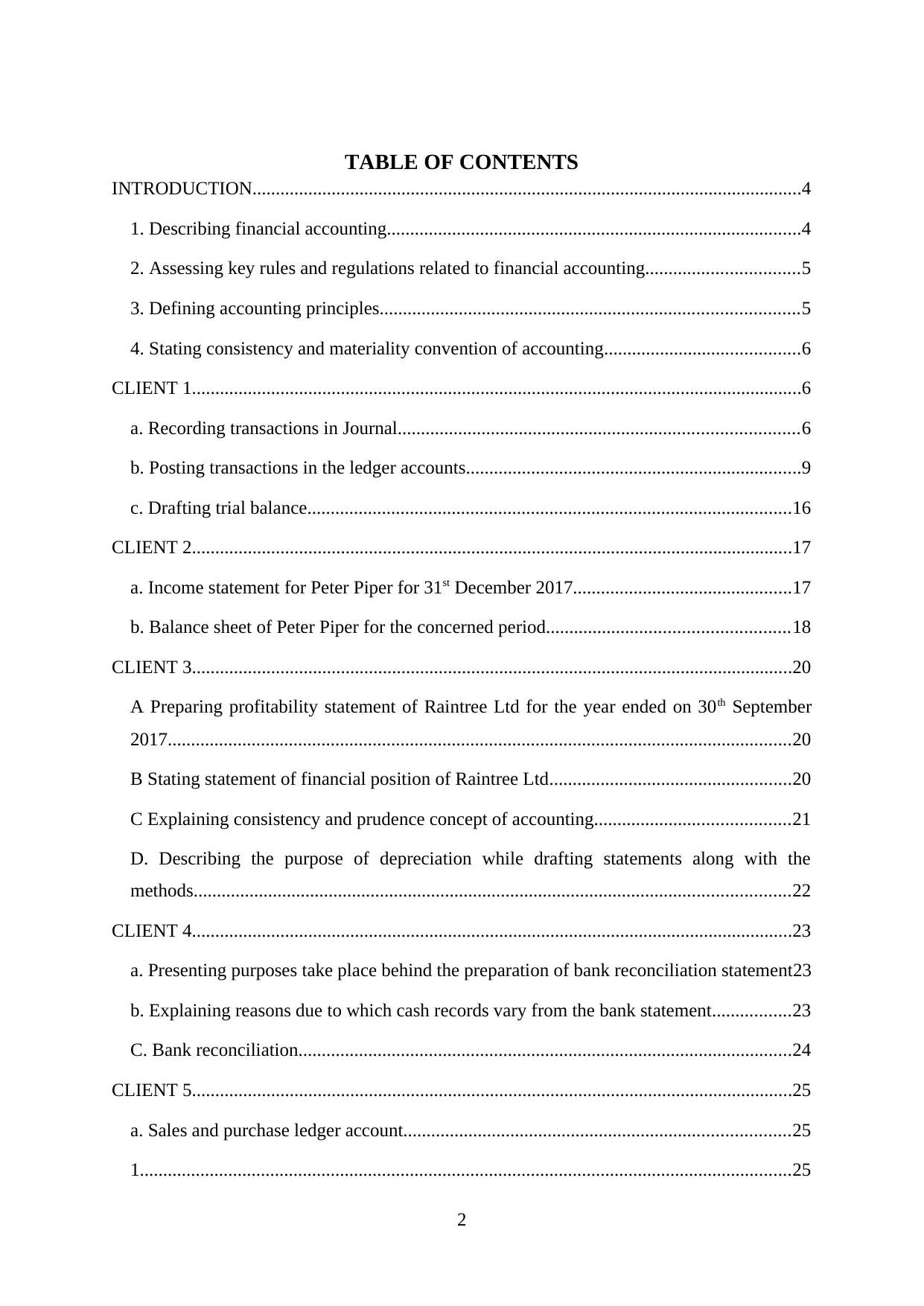
TABLE OF CONTENTS
INTRODUCTION......................................................................................................................4
1. Describing financial accounting.........................................................................................4
2. Assessing key rules and regulations related to financial accounting.................................5
3. Defining accounting principles..........................................................................................5
4. Stating consistency and materiality convention of accounting..........................................6
CLIENT 1...................................................................................................................................6
a. Recording transactions in Journal......................................................................................6
b. Posting transactions in the ledger accounts........................................................................9
c. Drafting trial balance........................................................................................................16
CLIENT 2.................................................................................................................................17
a. Income statement for Peter Piper for 31st December 2017...............................................17
b. Balance sheet of Peter Piper for the concerned period....................................................18
CLIENT 3.................................................................................................................................20
A Preparing profitability statement of Raintree Ltd for the year ended on 30th September
2017......................................................................................................................................20
B Stating statement of financial position of Raintree Ltd....................................................20
C Explaining consistency and prudence concept of accounting..........................................21
D. Describing the purpose of depreciation while drafting statements along with the
methods................................................................................................................................22
CLIENT 4.................................................................................................................................23
a. Presenting purposes take place behind the preparation of bank reconciliation statement23
b. Explaining reasons due to which cash records vary from the bank statement.................23
C. Bank reconciliation..........................................................................................................24
CLIENT 5.................................................................................................................................25
a. Sales and purchase ledger account...................................................................................25
1............................................................................................................................................25
2
INTRODUCTION......................................................................................................................4
1. Describing financial accounting.........................................................................................4
2. Assessing key rules and regulations related to financial accounting.................................5
3. Defining accounting principles..........................................................................................5
4. Stating consistency and materiality convention of accounting..........................................6
CLIENT 1...................................................................................................................................6
a. Recording transactions in Journal......................................................................................6
b. Posting transactions in the ledger accounts........................................................................9
c. Drafting trial balance........................................................................................................16
CLIENT 2.................................................................................................................................17
a. Income statement for Peter Piper for 31st December 2017...............................................17
b. Balance sheet of Peter Piper for the concerned period....................................................18
CLIENT 3.................................................................................................................................20
A Preparing profitability statement of Raintree Ltd for the year ended on 30th September
2017......................................................................................................................................20
B Stating statement of financial position of Raintree Ltd....................................................20
C Explaining consistency and prudence concept of accounting..........................................21
D. Describing the purpose of depreciation while drafting statements along with the
methods................................................................................................................................22
CLIENT 4.................................................................................................................................23
a. Presenting purposes take place behind the preparation of bank reconciliation statement23
b. Explaining reasons due to which cash records vary from the bank statement.................23
C. Bank reconciliation..........................................................................................................24
CLIENT 5.................................................................................................................................25
a. Sales and purchase ledger account...................................................................................25
1............................................................................................................................................25
2
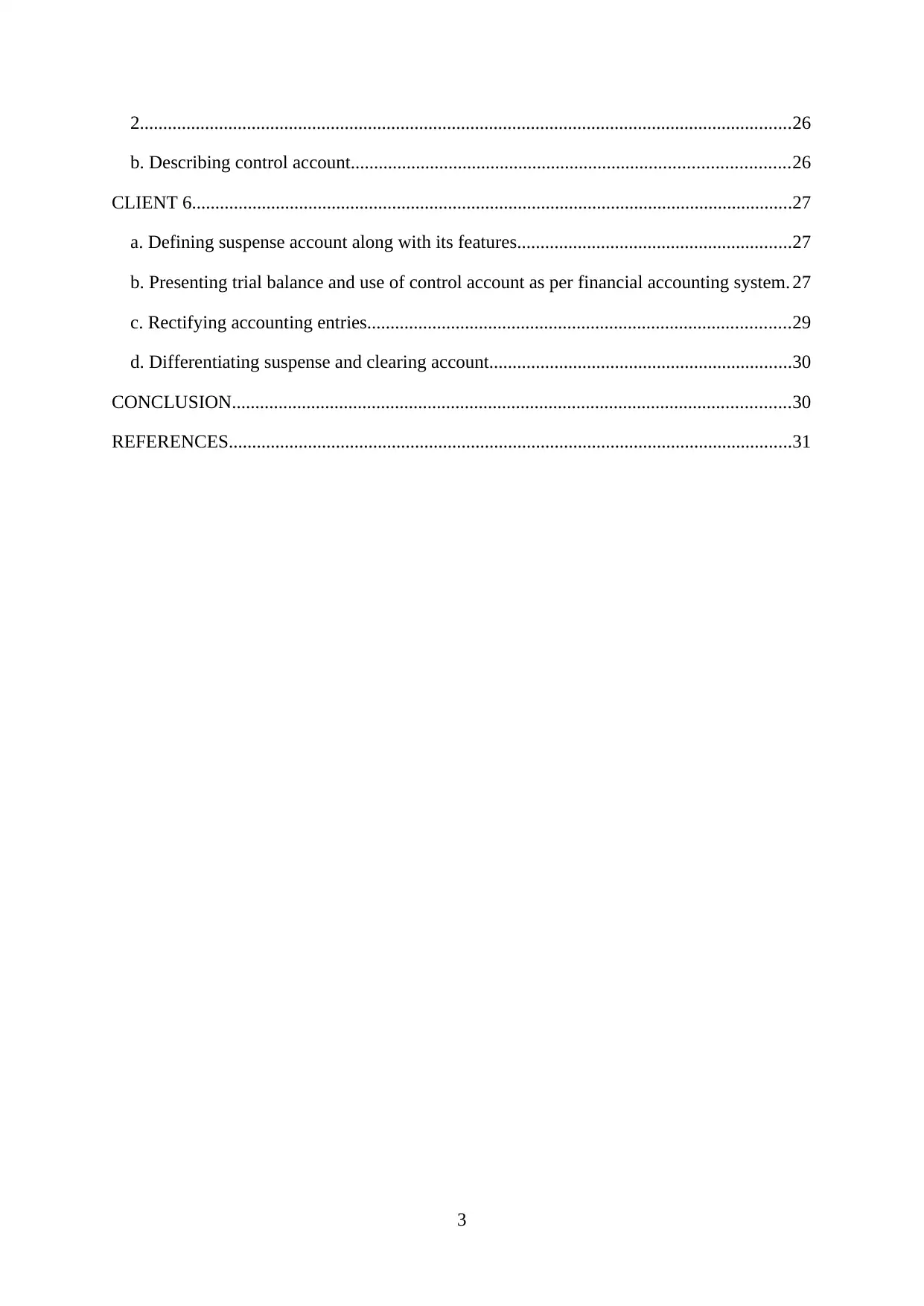
2............................................................................................................................................26
b. Describing control account..............................................................................................26
CLIENT 6.................................................................................................................................27
a. Defining suspense account along with its features...........................................................27
b. Presenting trial balance and use of control account as per financial accounting system. 27
c. Rectifying accounting entries...........................................................................................29
d. Differentiating suspense and clearing account.................................................................30
CONCLUSION........................................................................................................................30
REFERENCES.........................................................................................................................31
3
b. Describing control account..............................................................................................26
CLIENT 6.................................................................................................................................27
a. Defining suspense account along with its features...........................................................27
b. Presenting trial balance and use of control account as per financial accounting system. 27
c. Rectifying accounting entries...........................................................................................29
d. Differentiating suspense and clearing account.................................................................30
CONCLUSION........................................................................................................................30
REFERENCES.........................................................................................................................31
3
⊘ This is a preview!⊘
Do you want full access?
Subscribe today to unlock all pages.

Trusted by 1+ million students worldwide
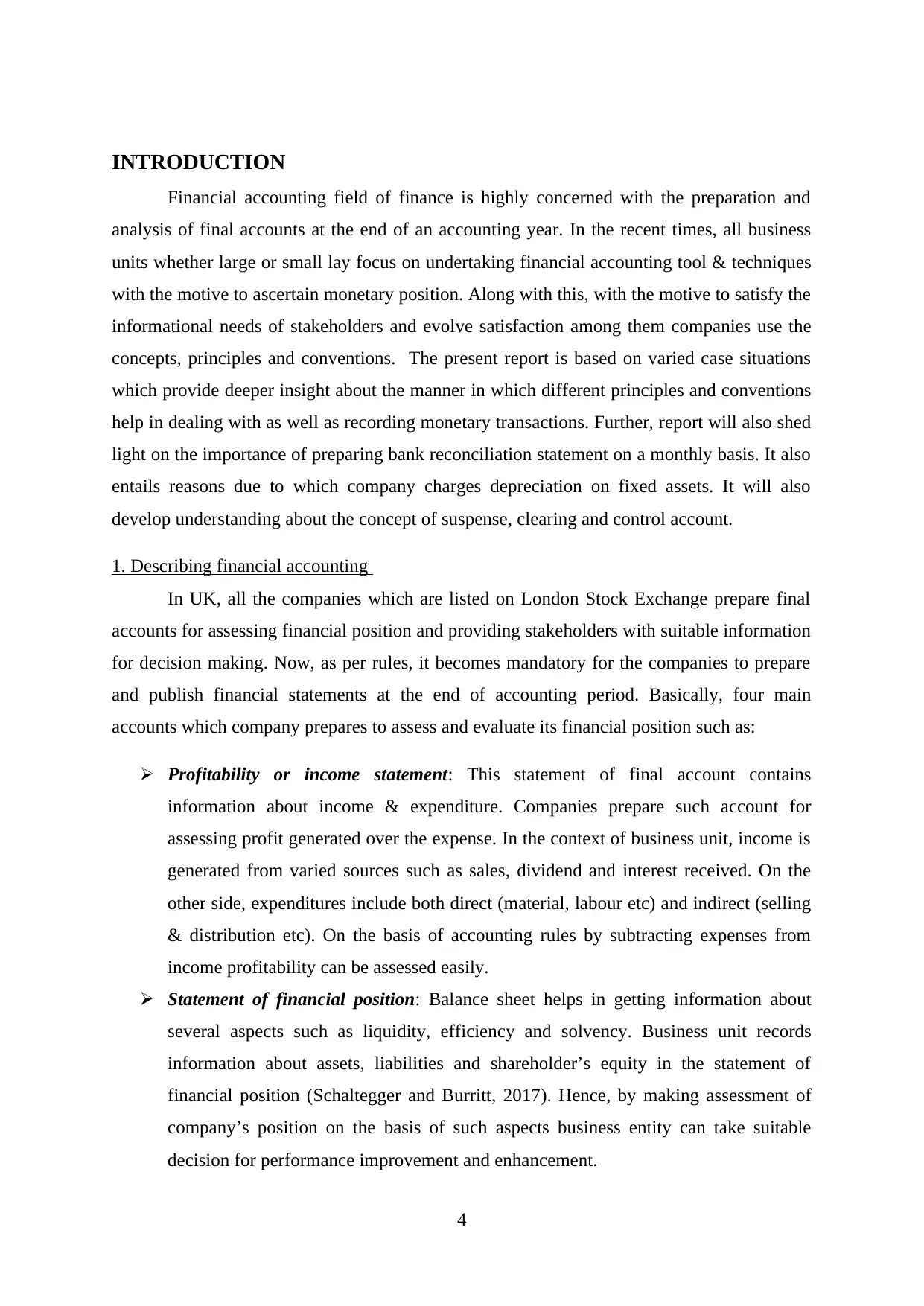
INTRODUCTION
Financial accounting field of finance is highly concerned with the preparation and
analysis of final accounts at the end of an accounting year. In the recent times, all business
units whether large or small lay focus on undertaking financial accounting tool & techniques
with the motive to ascertain monetary position. Along with this, with the motive to satisfy the
informational needs of stakeholders and evolve satisfaction among them companies use the
concepts, principles and conventions. The present report is based on varied case situations
which provide deeper insight about the manner in which different principles and conventions
help in dealing with as well as recording monetary transactions. Further, report will also shed
light on the importance of preparing bank reconciliation statement on a monthly basis. It also
entails reasons due to which company charges depreciation on fixed assets. It will also
develop understanding about the concept of suspense, clearing and control account.
1. Describing financial accounting
In UK, all the companies which are listed on London Stock Exchange prepare final
accounts for assessing financial position and providing stakeholders with suitable information
for decision making. Now, as per rules, it becomes mandatory for the companies to prepare
and publish financial statements at the end of accounting period. Basically, four main
accounts which company prepares to assess and evaluate its financial position such as:
Profitability or income statement: This statement of final account contains
information about income & expenditure. Companies prepare such account for
assessing profit generated over the expense. In the context of business unit, income is
generated from varied sources such as sales, dividend and interest received. On the
other side, expenditures include both direct (material, labour etc) and indirect (selling
& distribution etc). On the basis of accounting rules by subtracting expenses from
income profitability can be assessed easily.
Statement of financial position: Balance sheet helps in getting information about
several aspects such as liquidity, efficiency and solvency. Business unit records
information about assets, liabilities and shareholder’s equity in the statement of
financial position (Schaltegger and Burritt, 2017). Hence, by making assessment of
company’s position on the basis of such aspects business entity can take suitable
decision for performance improvement and enhancement.
4
Financial accounting field of finance is highly concerned with the preparation and
analysis of final accounts at the end of an accounting year. In the recent times, all business
units whether large or small lay focus on undertaking financial accounting tool & techniques
with the motive to ascertain monetary position. Along with this, with the motive to satisfy the
informational needs of stakeholders and evolve satisfaction among them companies use the
concepts, principles and conventions. The present report is based on varied case situations
which provide deeper insight about the manner in which different principles and conventions
help in dealing with as well as recording monetary transactions. Further, report will also shed
light on the importance of preparing bank reconciliation statement on a monthly basis. It also
entails reasons due to which company charges depreciation on fixed assets. It will also
develop understanding about the concept of suspense, clearing and control account.
1. Describing financial accounting
In UK, all the companies which are listed on London Stock Exchange prepare final
accounts for assessing financial position and providing stakeholders with suitable information
for decision making. Now, as per rules, it becomes mandatory for the companies to prepare
and publish financial statements at the end of accounting period. Basically, four main
accounts which company prepares to assess and evaluate its financial position such as:
Profitability or income statement: This statement of final account contains
information about income & expenditure. Companies prepare such account for
assessing profit generated over the expense. In the context of business unit, income is
generated from varied sources such as sales, dividend and interest received. On the
other side, expenditures include both direct (material, labour etc) and indirect (selling
& distribution etc). On the basis of accounting rules by subtracting expenses from
income profitability can be assessed easily.
Statement of financial position: Balance sheet helps in getting information about
several aspects such as liquidity, efficiency and solvency. Business unit records
information about assets, liabilities and shareholder’s equity in the statement of
financial position (Schaltegger and Burritt, 2017). Hence, by making assessment of
company’s position on the basis of such aspects business entity can take suitable
decision for performance improvement and enhancement.
4
Paraphrase This Document
Need a fresh take? Get an instant paraphrase of this document with our AI Paraphraser
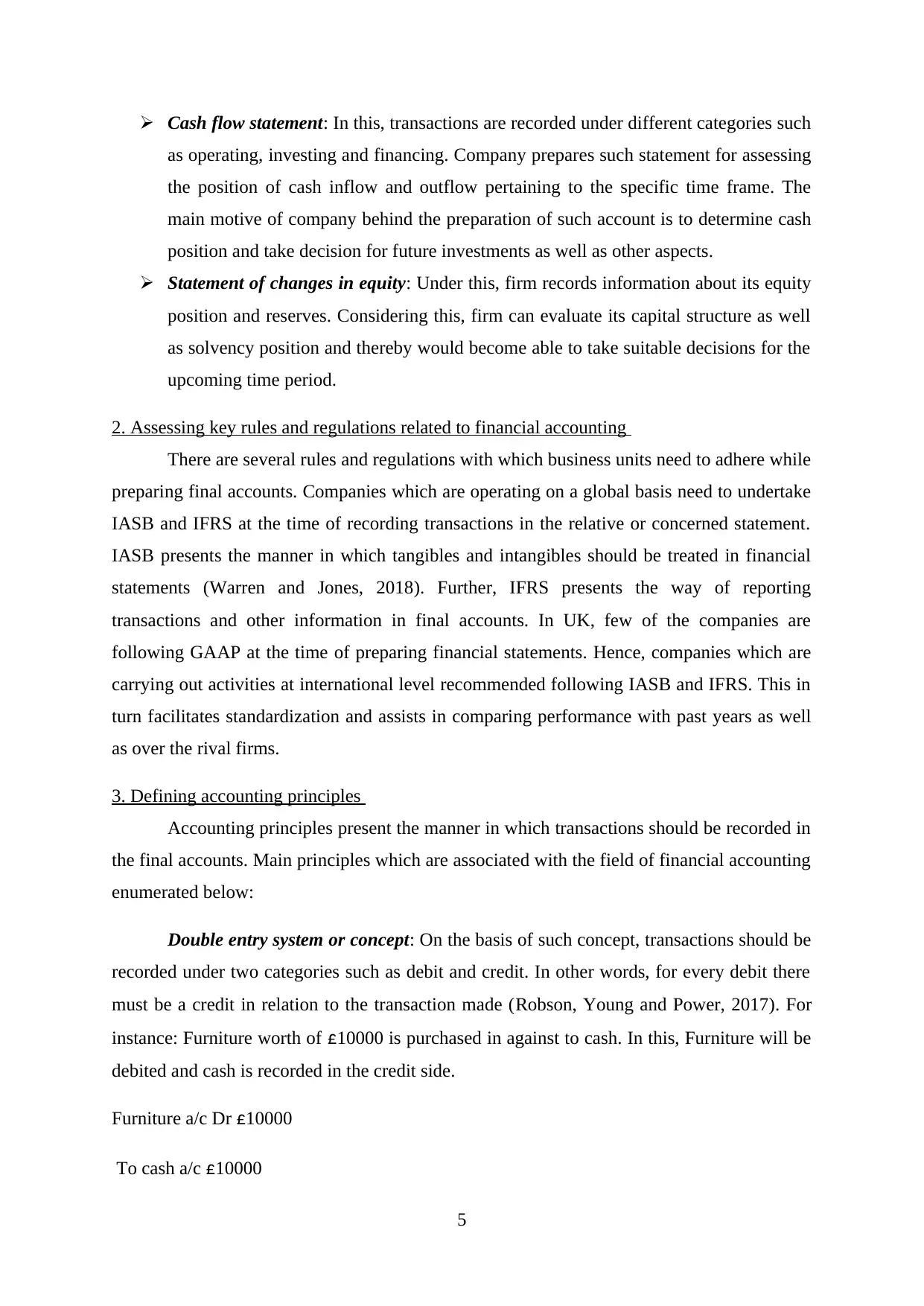
Cash flow statement: In this, transactions are recorded under different categories such
as operating, investing and financing. Company prepares such statement for assessing
the position of cash inflow and outflow pertaining to the specific time frame. The
main motive of company behind the preparation of such account is to determine cash
position and take decision for future investments as well as other aspects.
Statement of changes in equity: Under this, firm records information about its equity
position and reserves. Considering this, firm can evaluate its capital structure as well
as solvency position and thereby would become able to take suitable decisions for the
upcoming time period.
2. Assessing key rules and regulations related to financial accounting
There are several rules and regulations with which business units need to adhere while
preparing final accounts. Companies which are operating on a global basis need to undertake
IASB and IFRS at the time of recording transactions in the relative or concerned statement.
IASB presents the manner in which tangibles and intangibles should be treated in financial
statements (Warren and Jones, 2018). Further, IFRS presents the way of reporting
transactions and other information in final accounts. In UK, few of the companies are
following GAAP at the time of preparing financial statements. Hence, companies which are
carrying out activities at international level recommended following IASB and IFRS. This in
turn facilitates standardization and assists in comparing performance with past years as well
as over the rival firms.
3. Defining accounting principles
Accounting principles present the manner in which transactions should be recorded in
the final accounts. Main principles which are associated with the field of financial accounting
enumerated below:
Double entry system or concept: On the basis of such concept, transactions should be
recorded under two categories such as debit and credit. In other words, for every debit there
must be a credit in relation to the transaction made (Robson, Young and Power, 2017). For
instance: Furniture worth of £10000 is purchased in against to cash. In this, Furniture will be
debited and cash is recorded in the credit side.
Furniture a/c Dr £10000
To cash a/c £10000
5
as operating, investing and financing. Company prepares such statement for assessing
the position of cash inflow and outflow pertaining to the specific time frame. The
main motive of company behind the preparation of such account is to determine cash
position and take decision for future investments as well as other aspects.
Statement of changes in equity: Under this, firm records information about its equity
position and reserves. Considering this, firm can evaluate its capital structure as well
as solvency position and thereby would become able to take suitable decisions for the
upcoming time period.
2. Assessing key rules and regulations related to financial accounting
There are several rules and regulations with which business units need to adhere while
preparing final accounts. Companies which are operating on a global basis need to undertake
IASB and IFRS at the time of recording transactions in the relative or concerned statement.
IASB presents the manner in which tangibles and intangibles should be treated in financial
statements (Warren and Jones, 2018). Further, IFRS presents the way of reporting
transactions and other information in final accounts. In UK, few of the companies are
following GAAP at the time of preparing financial statements. Hence, companies which are
carrying out activities at international level recommended following IASB and IFRS. This in
turn facilitates standardization and assists in comparing performance with past years as well
as over the rival firms.
3. Defining accounting principles
Accounting principles present the manner in which transactions should be recorded in
the final accounts. Main principles which are associated with the field of financial accounting
enumerated below:
Double entry system or concept: On the basis of such concept, transactions should be
recorded under two categories such as debit and credit. In other words, for every debit there
must be a credit in relation to the transaction made (Robson, Young and Power, 2017). For
instance: Furniture worth of £10000 is purchased in against to cash. In this, Furniture will be
debited and cash is recorded in the credit side.
Furniture a/c Dr £10000
To cash a/c £10000
5
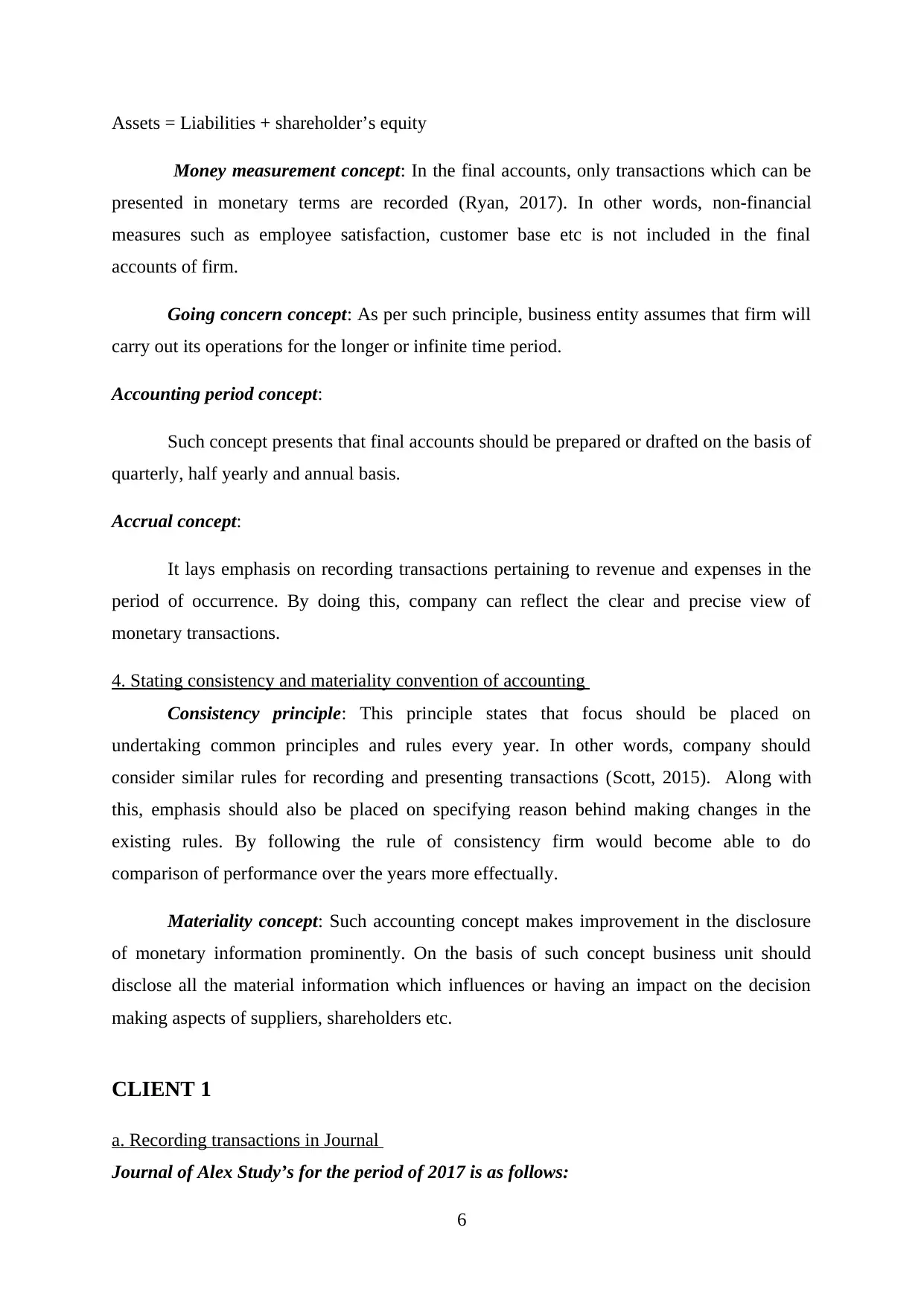
Assets = Liabilities + shareholder’s equity
Money measurement concept: In the final accounts, only transactions which can be
presented in monetary terms are recorded (Ryan, 2017). In other words, non-financial
measures such as employee satisfaction, customer base etc is not included in the final
accounts of firm.
Going concern concept: As per such principle, business entity assumes that firm will
carry out its operations for the longer or infinite time period.
Accounting period concept:
Such concept presents that final accounts should be prepared or drafted on the basis of
quarterly, half yearly and annual basis.
Accrual concept:
It lays emphasis on recording transactions pertaining to revenue and expenses in the
period of occurrence. By doing this, company can reflect the clear and precise view of
monetary transactions.
4. Stating consistency and materiality convention of accounting
Consistency principle: This principle states that focus should be placed on
undertaking common principles and rules every year. In other words, company should
consider similar rules for recording and presenting transactions (Scott, 2015). Along with
this, emphasis should also be placed on specifying reason behind making changes in the
existing rules. By following the rule of consistency firm would become able to do
comparison of performance over the years more effectually.
Materiality concept: Such accounting concept makes improvement in the disclosure
of monetary information prominently. On the basis of such concept business unit should
disclose all the material information which influences or having an impact on the decision
making aspects of suppliers, shareholders etc.
CLIENT 1
a. Recording transactions in Journal
Journal of Alex Study’s for the period of 2017 is as follows:
6
Money measurement concept: In the final accounts, only transactions which can be
presented in monetary terms are recorded (Ryan, 2017). In other words, non-financial
measures such as employee satisfaction, customer base etc is not included in the final
accounts of firm.
Going concern concept: As per such principle, business entity assumes that firm will
carry out its operations for the longer or infinite time period.
Accounting period concept:
Such concept presents that final accounts should be prepared or drafted on the basis of
quarterly, half yearly and annual basis.
Accrual concept:
It lays emphasis on recording transactions pertaining to revenue and expenses in the
period of occurrence. By doing this, company can reflect the clear and precise view of
monetary transactions.
4. Stating consistency and materiality convention of accounting
Consistency principle: This principle states that focus should be placed on
undertaking common principles and rules every year. In other words, company should
consider similar rules for recording and presenting transactions (Scott, 2015). Along with
this, emphasis should also be placed on specifying reason behind making changes in the
existing rules. By following the rule of consistency firm would become able to do
comparison of performance over the years more effectually.
Materiality concept: Such accounting concept makes improvement in the disclosure
of monetary information prominently. On the basis of such concept business unit should
disclose all the material information which influences or having an impact on the decision
making aspects of suppliers, shareholders etc.
CLIENT 1
a. Recording transactions in Journal
Journal of Alex Study’s for the period of 2017 is as follows:
6
⊘ This is a preview!⊘
Do you want full access?
Subscribe today to unlock all pages.

Trusted by 1+ million students worldwide
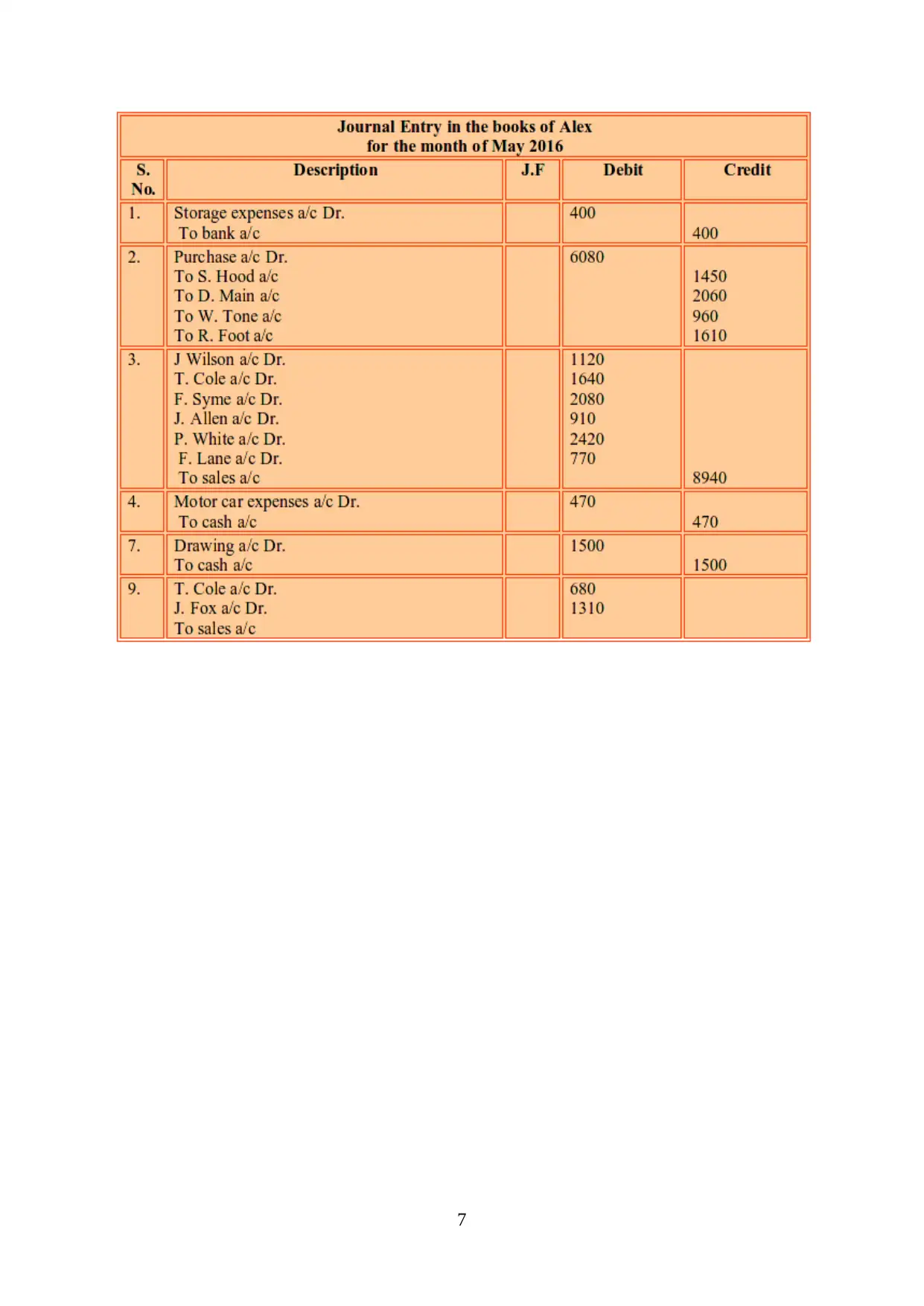
7
Paraphrase This Document
Need a fresh take? Get an instant paraphrase of this document with our AI Paraphraser
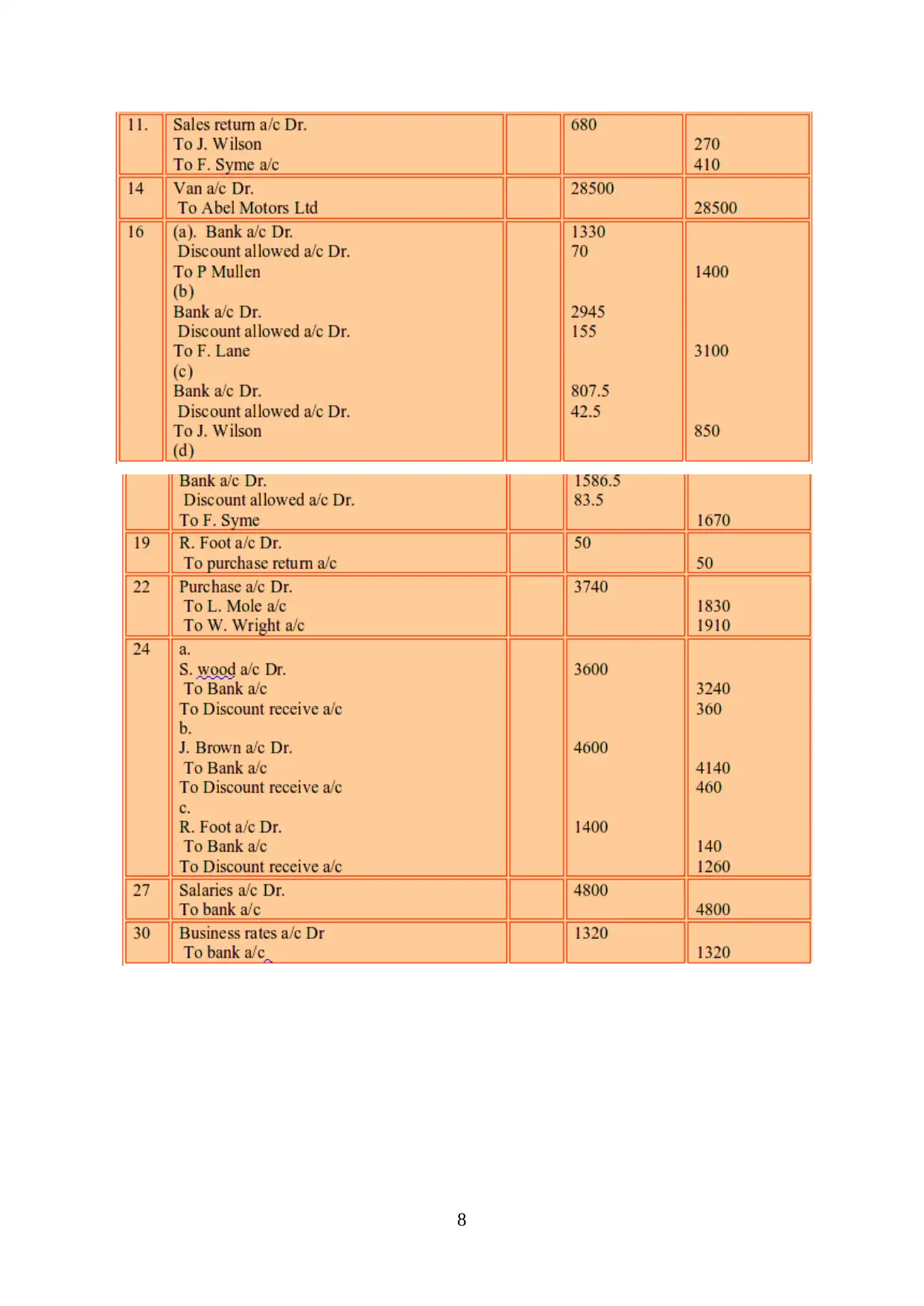
8
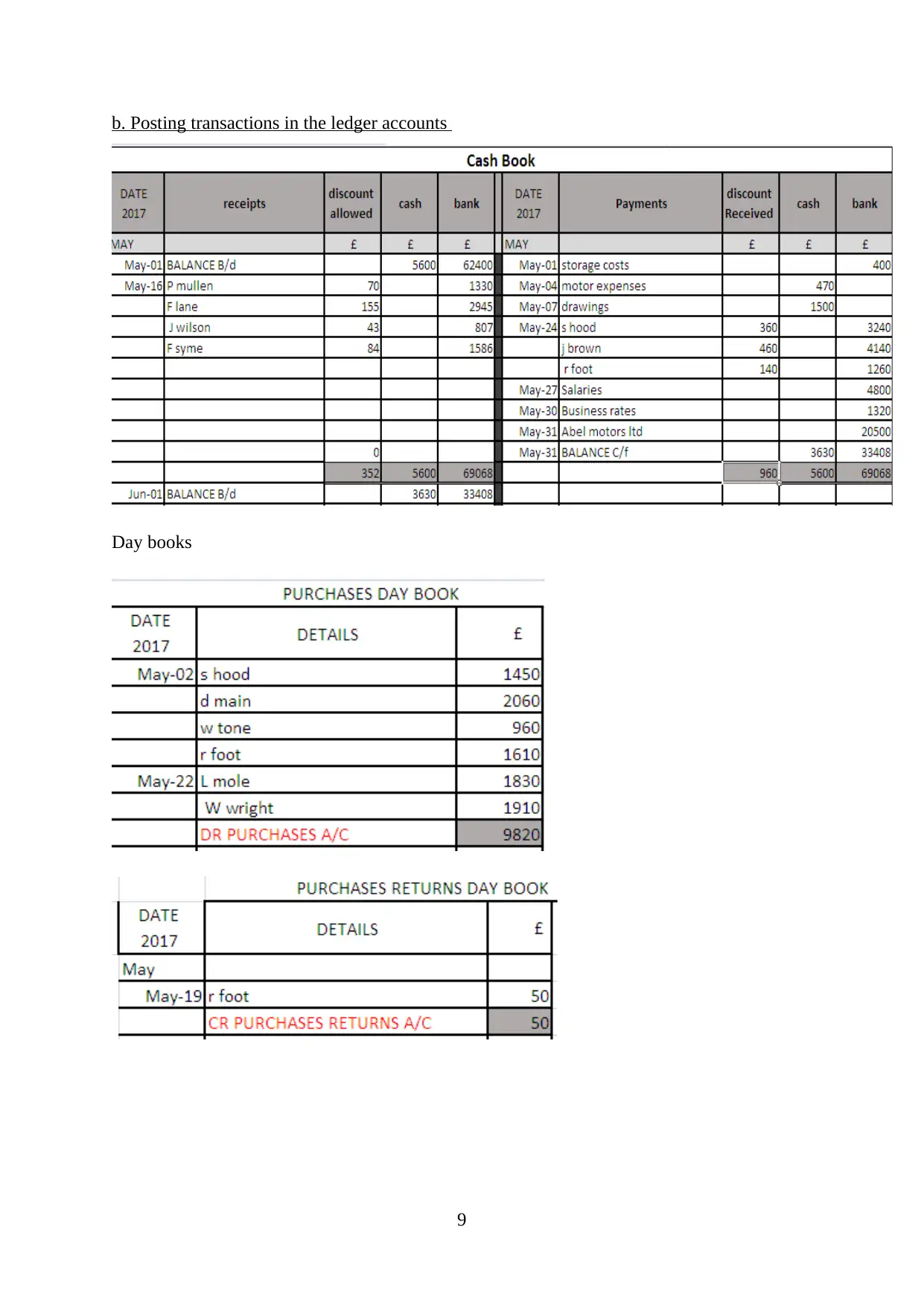
b. Posting transactions in the ledger accounts
Day books
9
Day books
9
⊘ This is a preview!⊘
Do you want full access?
Subscribe today to unlock all pages.

Trusted by 1+ million students worldwide
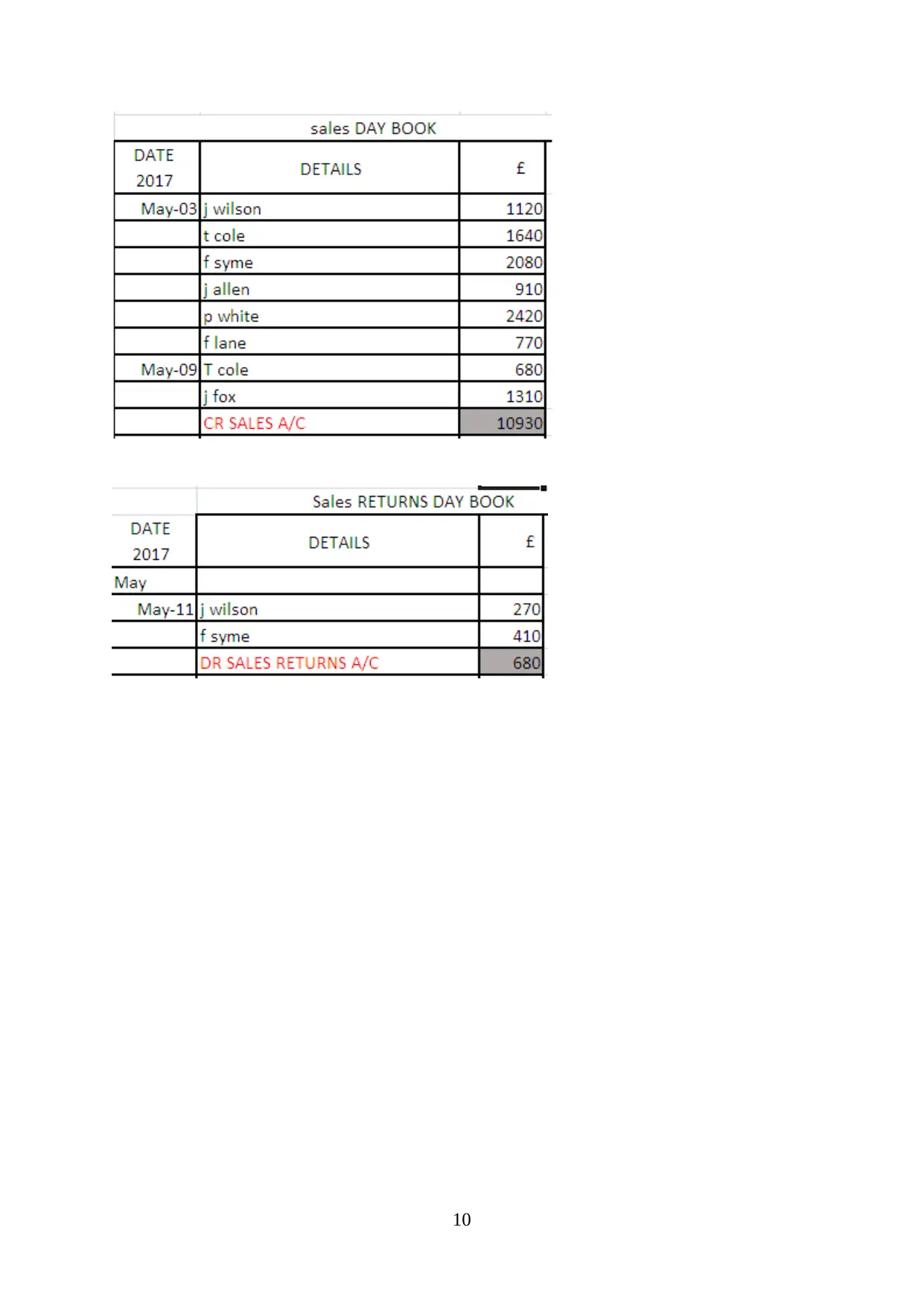
10
Paraphrase This Document
Need a fresh take? Get an instant paraphrase of this document with our AI Paraphraser
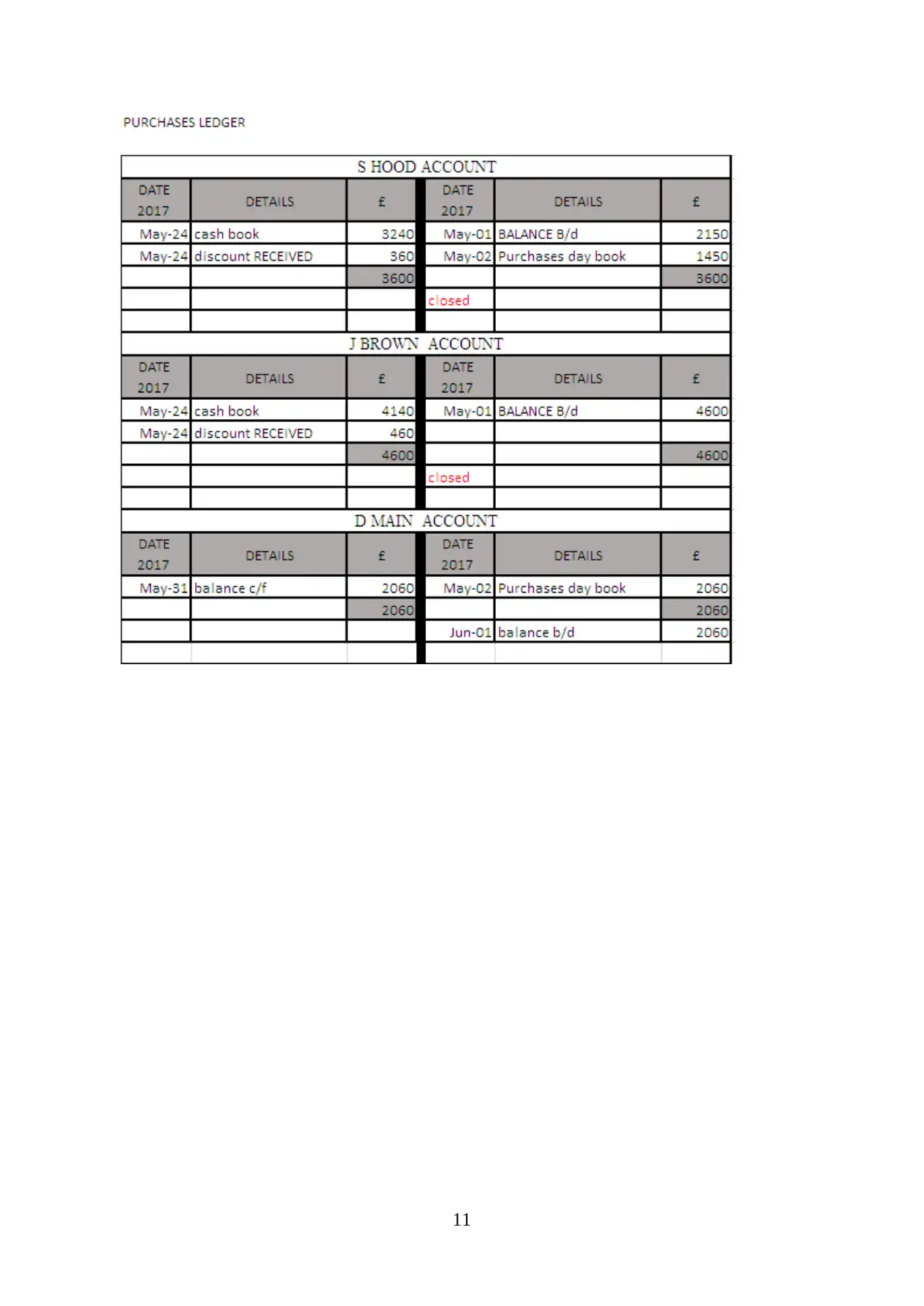
11
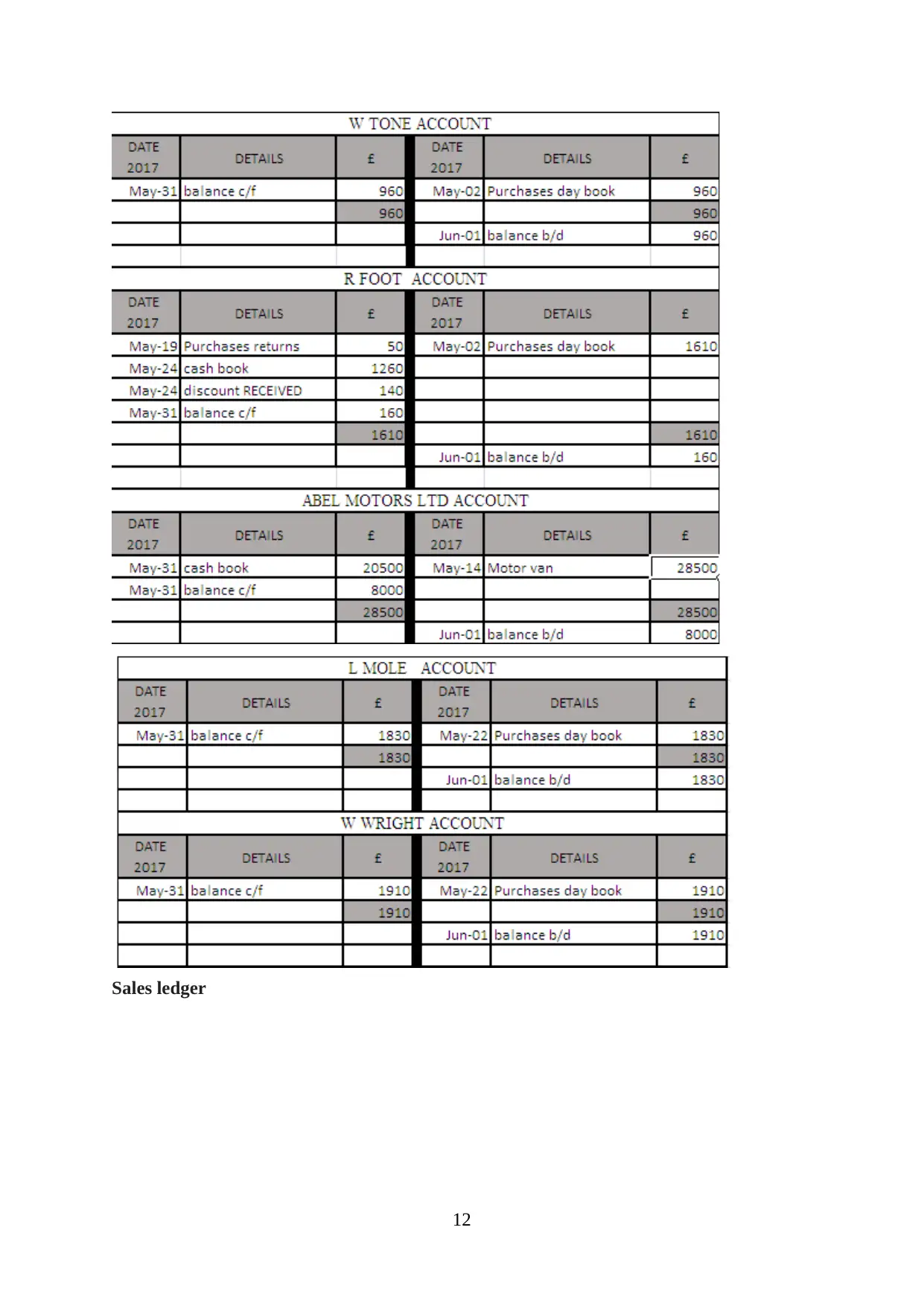
Sales ledger
12
12
⊘ This is a preview!⊘
Do you want full access?
Subscribe today to unlock all pages.

Trusted by 1+ million students worldwide
1 out of 32
Related Documents
Your All-in-One AI-Powered Toolkit for Academic Success.
+13062052269
info@desklib.com
Available 24*7 on WhatsApp / Email
![[object Object]](/_next/static/media/star-bottom.7253800d.svg)
Unlock your academic potential
Copyright © 2020–2025 A2Z Services. All Rights Reserved. Developed and managed by ZUCOL.





